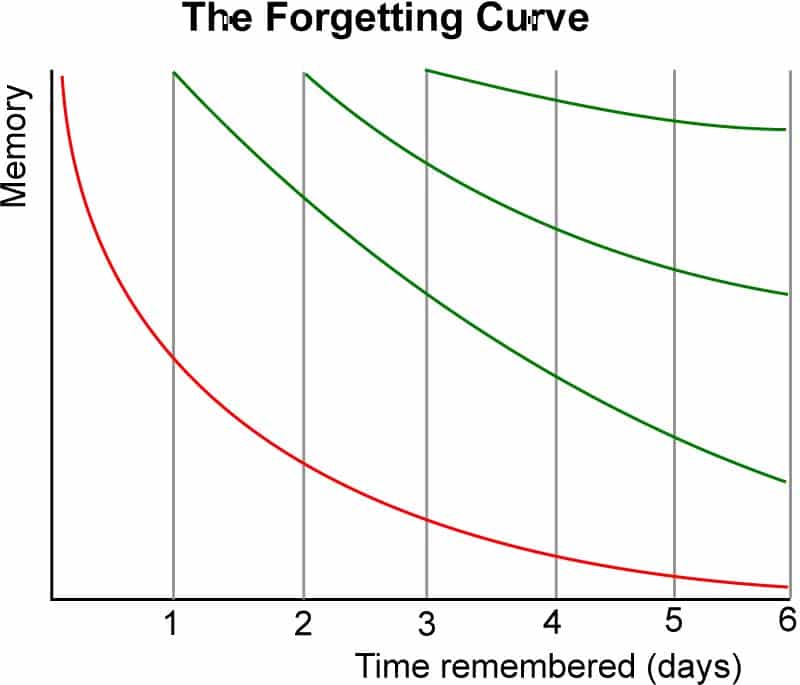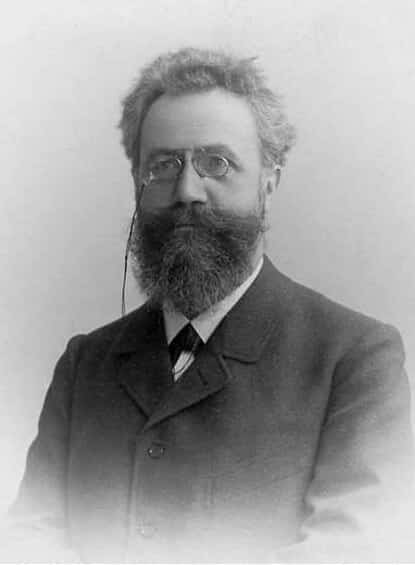- Forgetting is a natural and necessary part of life. It allows us to move on from bad experiences, and it helps us make new memories.
- The Ebbinghaus forgetting curve is a graph that depicts how the rate of human memory decay varies over time.
- Using strategic study methods such as active recall and spaced repetition helps you combat memory decay as a student.
After receiving a new piece of information, the medial temporal lobe of your brain is usually capable of saving that information in memory for a few days or even weeks. But, without using methods such as spaced repetition or active recall, your brain will not be able to store that memory for long due to memory trace decay and interference – a process more commonly known as “forgetting.”
The rate and speed at which forgetting takes place are often visualized as a curve: the Ebbinghaus forgetting curve. This curve shows an astoundingly steep memory decline in the first 24 hours, followed by a slower decline in the days after that. Initially proposed by Hermann Ebbinghaus in 1885, the existence of this forgetting curve has been confirmed countless times by researchers across different fields. Most recently in 2013, 2015, 2017, and 2021.

The rapidity of forgetting indicated by this curve is remarkable, and combating its effects should be a top priority for any student and educator, whether they are in an offline or online learning environment. However, not all forgetting is bad. In fact, forgetting has an important role in human memory in that it leads to a higher rate of retention in the long term. Forgetting bits of information and then recalling them is a much more effective strategy than re-reading the same information multiple times and attempting to “solidify” the knowledge in that way.
That is why in the “How to combat the curve of forgetting” section of this article, I’ll be covering tips on how to achieve a delicate state of balance between memorization and forgetting. With these tips, you can turn your forgetfulness into a superpower. In addition to that, I’ll be going over the nitty-gritty of the Ebbinghaus forgetting curve: what it is and who’s the man behind it.
In this guide, you’ll learn the following:
The Ebbinghaus Forgetting Curve
What is the Ebbinghaus forgetting curve?
The Ebbinghaus forgetting curve is a graph that shows the rate at which human memory deteriorates over time. It is characterized by memories going through an initial stage of rapid memory decline within 24 hours, followed by a slower rate of memory decay over the long term.
This curve of forgetting shows us that:
- Forgetting is a natural and necessary part of life.
- Avoiding forgetting altogether is a never-ending uphill battle due to the human brain’s natural tendency to forget things.
- Nearly all our memories of a given event are lost within the first 24 hours.
- Learning methods and learning frequency play a role in the memory decay rate.
- Avoiding memory trace decay is best done by learning through repetitions over long periods of time rather than using “cramming.”
The forgetting curve in memory can be offset by a number of factors and techniques, such as spaced repetition, active recall, and other memory techniques, such as Leitner’s flashcard system. These methods can increase your rates of long-term memory retention by regularly forcing you to recall forgotten facts and concepts.
The formula with which the Ebbinghaus curve of forgetting is calculated is the following: R = exp(-t/S), with R symbolizing memory retention, t symbolizing time, and S the relative strength of the memory.
Who was Hermann Ebbinghaus?

Hermann Ebbinghaus was a German psychologist and philosopher most well-known for his research on the forgetting curve and the spacing effect. His groundbreaking work on the forgetting curve was published in his paper “Memory: A Contribution to Experimental Psychology” in 1885.
Now, how did he arrive at his memory theory?
Hermann Ebbinghaus gained an interest in psychology while studying history and philology at the University of Bonn, and he completed his Ph.D. in philosophy in 1873, after which he founded some of Europe’s first psychological testing laboratories in Germany and Poland.
Hermann Ebbinghaus is considered one of the fathers of experimental psychology due to his first-in-history systematic study of memory, published in 1885. He conducted several experiments on human learning and forgetting that led him to conclude that forgetting over long periods is proportional to how often something has been remembered previously. This discovery meant that it’s not just about how much information you’re exposed to, but it’s also important how frequently these memories are recalled again.
Not only did the work of Ebbinghaus inspire future generations of memory researchers, but he also campaigned for additional funding for memory research and supported scientific research in psychology at a time when psychology was seen as a sort of pseudoscience by many scientists.
How to combat the curve of forgetting
Choose to use active recall instead of a passive review
Active recall refers to reviewing materials in an active and self-directed manner with the help of tools such as flashcards or self-quizzes. This learning style is vastly different from conducting a passive review in which the learner simply reads the information without trying to actively recall what they’ve learned. Active recall forces learners to actively participate in the learning process and to think about the material in a deeper way, forming stronger memories as a result.
By using active recall, you will make sure that the information has a better chance of sticking in your long-term memory. You’ll also be able to retain more of what you’ve learned because there will be new neural connections formed due to your critical thinking skills being more engaged.
Practicing active recall instead of passive reviewing is beneficial for combating the forgetting curve because it:
- Results in deeper and stronger memory traces.
- Self-testing yourself once achieves better results than rereading information four times.
- Forces you to learn without any guidance, thus improving long-term retention and exam test results.
Now, let’s go over another closely related learning concept – spaced repetition.
Use spaced repetition to achieve better memory retention
Spaced repetition refers to the practice of repeating and recalling information at specific time intervals. When you review information in a given interval, it’s easier to remember because each successive review goes over the same concepts over and over. This process reduces forgetting, improves retention over time, and takes advantage of the Ebbinghaus forgetting curve.
The Ebbinghaus forgetting curve demonstrates that as you go through repetitions of the information, your recall of it gets better. At first, training is not effective because there are many new items to remember. However, as time passes and more words build on each other through repetition, they become simpler to recall because the neural pathways in your brain get stronger.
The spaced repetition memory technique is based on this concept. If you use the spaced repetition technique, you’re constantly recalling the same information and combating the onset of the curve of forgetting. The spaced repetition technique can be especially powerful with modern tools such as Anki or SuperMemo, which use powerful algorithms to train your memory in the most optimized ways possible.
Hundreds of studies have highlighted the benefits of spaced repetition, and these benefits include:
- Continuously re-exposing your brain to the same information at various intervals.
- Developing stronger memory traces through repeated recall.
- Repeated and consistent learning in short study sessions produces less anxiety for exams.
Use mnemonics to combat the curve of forgetting
To make the information more relevant and engaging, consider using mnemonics to combat the curve of forgetting. The use of mnemonics in learning dates back all the way to 477 BCE, and they are still just as effective as ever. Using mnemonics helps you remember more by associating the learned information with a word, phrase, or sentence which you already have in your long-term memory.
As an example, picture yourself in geography class, trying to memorize the differences between “longitude” and “latitude.” Here, mnemonics can be of great help. If you look at a globe, the lines that run across North and South are long, and these lines also symbolize “longitude.” Thus, to remember the direction of longitude, you could simply remember that the longitudinal lines are long.
Simon Reinhard, a world record-holding memory athlete capable of memorizing the order of an entire deck of cards in less than half a minute, also heavily relies on using mnemonics to remember things better.
Making connections in your brain with the use of mnemonics can help you:
- Create stronger memory traces.
- Helps encode information into long-term memory.
- Learn large amounts of information and ordered lists with relative ease.
Make the information relevant to yourself
There’s another effective technique to make learning and memorizing easier – making it relevant to yourself. The more relevant the information is, the easier it is for your brain to make a connection with what you already know and thus allow you to remember it. By connecting our own personal experiences with the topic, we can enhance the storing capacities of our brains and enhance memory trace retention.
There are three ways to make information more relevant:
- Connecting new information with what you already know.
- Making the new material sound as interesting or important to you as possible.
- Framing the new knowledge with your personal goals and experiences.
Besides relatedness and relevancy, there’s another effective technique to combat the curve of forgetting: social interactivity.
Add an element of social interaction
Our memories get stronger when we are actively involved in the learning process rather than being passive observers. This element of social interactivity is crucial in combating the forgetting curve because it strengthens the neurons in our brains and makes them more likely to establish long-lasting memory traces.
Participating in social interactions while going over the learning materials can help create a productive environment for memory encoding. And not only is social interaction important for the creation of memories, but it also enhances memory recall. However, for socially interactive learning to be effective, some of its disadvantages, such as ease of distraction and a lack of accountability, have to be taken into consideration.
Here are a few ways to make learning materials more socially interactive:
- Creating active learning environments such as “flipped classrooms” where students are actively involved in solving problems rather than passively listening to lectures.
- Working in small groups to solve problems and share knowledge.
- Doing hands-on experiments and solving real-world challenges.
- Participating in online forum discussions and learner communities.
In conclusion: Why is the curve of forgetting important?
In conclusion, the Ebbinghaus forgetting curve helps us to better understand the forgetting patterns of our memories. It shows that we tend to forget things very quickly but also that the effect can be combated through various methods such as spaced repetition, active recall, and mnemonics.
Human memory is a complex mechanism that can work against us as we age, but it’s also a mechanism that can be optimized and improved with the help of specific strategies. We can take an active role in improving our memory retention, and while it’s not always easy, it’s more than worth going the extra mile.
Through his work, Hermann Ebbinghaus helped us to better understand how our memories work, and for that reason, he will always be considered one of the pioneers of memory research. If you’d like to read more about the past, present, and future of learning research, make sure to read some of our other posts on study skills.


